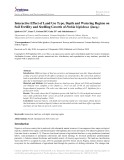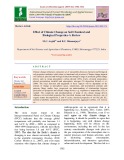
Soil nutrient deposit
-
Different types of land use, practices and management can alter biogeochemical cycling of a piece of land by the effect it produces on soil properties. The conversion of forest land to agricultural land and wastelands to forest land use have been in practice from primordial days due to land hunger and reclamation.
 7p
7p  viporsche
viporsche
 28-10-2022
28-10-2022
 4
4
 2
2
 Download
Download
-
Nesting water bird colonies may act as important drivers of aquatic-terrestrial nutrient turnover in coastal ecosystems. By depositing a large amount of guano, they induce changes in the structure of soils, flora, and fauna. However, little is known about how nesting water bird colonies influence soil fauna, especially in a Mediterranean type of coastal landscape.
 9p
9p  dolomite36
dolomite36
 30-12-2021
30-12-2021
 7
7
 0
0
 Download
Download
-
Nitrogen is the key nutrient factor that influences soil fertility and productivity. It is the mineral nutrient that exists in different forms, but nitrate form is the most preferred form by plants. Irrespective of the form in which N is applied to soil, it undergoes transformation viz. mineralization (ammonification, nitrification), denitrification etc. by enzymes produced by micro organisms.
 17p
17p  trinhthamhodang7
trinhthamhodang7
 31-08-2020
31-08-2020
 24
24
 0
0
 Download
Download
-
Climate change influences composite set of measurable physical, chemical and biological soil properties attributes which relate to functional soil processes. Climate change impacts soil chemical, physical and biological functions through a range of predicted global change drivers such as rising atmospheric carbon dioxide (CO2) levels, elevated temperature, altered precipitation (rainfall) and atmospheric nitrogen (N) deposition (French et al., 2009).
 11p
11p  cothumenhmong1
cothumenhmong1
 08-12-2019
08-12-2019
 27
27
 1
1
 Download
Download
-
Non-point source controls washed off fields is the largest source of agricultural pollution in the United States. Farmers may utilize to reduce runoff flows and retain soil on their fields. Common techniques include contour plowing, crop mulching, crop rotation, planting perennial crops and installing riparian buffers. Nutrients nitrogen and phosphorus are typically applied to farmland as commercial fertilizer; animal manure; or spraying of municipal or industrial waste water (effluent) or sludge.
 5p
5p  tainhacmienphi
tainhacmienphi
 19-02-2013
19-02-2013
 86
86
 6
6
 Download
Download
-
Sewage sludge as an uncalled for product of wastewater treatment poses the challenge to society of disposing of it, but at the same time gives us the opportunity of beneficial use by closing the cycle of nutrients: sludge derived from agricultural activity must return to soil if a sustainable and ecologically sound management of these materials is desirable (SEQUI et al. 2000). At present the major ways of disposing of sewage sludges are deposition, landfill and incineration, only part of the sludges are used in agriculture. ...
 30p
30p  ut_hai_can
ut_hai_can
 29-12-2012
29-12-2012
 71
71
 8
8
 Download
Download
-
The chemical properties of organics of health concern – hydrophobic and not water soluble - results in a low bioavailability to plants. Plant growth is dependent on the water solubility of nutrients and minerals and water is the transporting vector. Organics with a low water solubility will therefore not be taken up by plants. The presence of organic environmental pollutants, like dioxins and PCBs in agricultural crops is more the result of atmospheric deposition than direct absorption from contaminated soil.
 93p
93p  ut_hai_can
ut_hai_can
 29-12-2012
29-12-2012
 79
79
 5
5
 Download
Download
CHỦ ĐỀ BẠN MUỐN TÌM



















